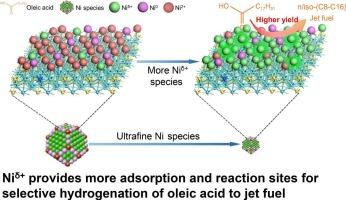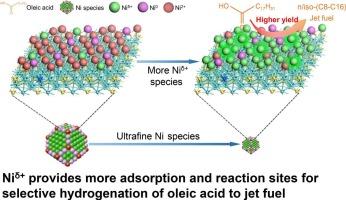Insights into the roles of Niδ+ species on the selective hydrogenation of oleic acid to jet fuel
IF 6.5
1区 化学
Q2 CHEMISTRY, PHYSICAL
引用次数: 0
Abstract
Revealing the exact catalytic sites and reaction mechanism is crucial for the production of bio-jet fuel from biomass-derived oleic acid. The activation of C–O bonds and C–C bonds of oleic acid were the keys in waste oil upgrading, yet the active sites and mechanism still remain inconclusive on Ni-based catalysts. Herein, we studied the activation characteristics of C-O bonds and C–C bonds of Ni species to clearly distinguish the role of Niδ+ of Ni-based catalysts in selective hydrogenation reaction. The ultrafine Ni species of Ni/ZS-NP (Ni/ZSM-22-SBA-15) promoted the generation of more Niδ+ species, which could greatly facilitate the adsorption of reactants. Then the adsorbed carboxyl groups on Niδ+ was further hydrogenated by H, which was activated by the adjacent metal sites. Meanwhile, the activation of C-O and C–C bonds adsorbed on Niδ+ species occurred in the subsequently selective hydrogenation process, and the higher jet fuel yield implied that the activation of C–C bonds by Niδ+ species in the isomerization and hydrocracking reactions was particularly significant. Ni/ZS-NP exhibited the higher jet fuel yield of 62.3 % and the higher iso/n alkane ratio of 3.33 at 320 °C, which were superior to the catalysts reported in the previous literature. These findings distinguish different roles of Ni species in Ni-based catalysts, providing different insights into the fundamental understanding of the selective hydrogenation process of oleic acid hydrogenation to jet fuel.


ni +在油酸选择性加氢制喷气燃料中的作用
揭示准确的催化位点和反应机理对生物质油酸制备生物喷气燃料具有重要意义。油酸C-O键和C-C键的活化是废油转化的关键,但镍基催化剂的活性位点和活性机理尚无定论。本文通过研究Ni种的C-O键和C-C键的活化特性,明确区分Ni基催化剂的Niδ+在选择性加氢反应中的作用。Ni/ZS-NP的超细Ni态(Ni/ZSM-22-SBA-15)促进了更多Niδ+的生成,极大地促进了反应物的吸附。然后吸附在ni +上的羧基被H进一步氢化,H被相邻的金属位激活。同时,在随后的选择性加氢过程中,吸附在ni +上的C-O键和C-C键发生了活化,较高的喷气燃料产率表明ni +在异构化和加氢裂化反应中对C-C键的活化尤为显著。在320 ℃时,Ni/ZS-NP的喷气燃料产率为62.3 %,iso/n烷烃比为3.33,优于文献报道的催化剂。这些发现区分了Ni在Ni基催化剂中的不同作用,为油酸加氢制备航空燃料的选择性加氢过程的基本认识提供了不同的见解。
本文章由计算机程序翻译,如有差异,请以英文原文为准。
求助全文
约1分钟内获得全文
求助全文
来源期刊

Journal of Catalysis
工程技术-工程:化工
CiteScore
12.30
自引率
5.50%
发文量
447
审稿时长
31 days
期刊介绍:
The Journal of Catalysis publishes scholarly articles on both heterogeneous and homogeneous catalysis, covering a wide range of chemical transformations. These include various types of catalysis, such as those mediated by photons, plasmons, and electrons. The focus of the studies is to understand the relationship between catalytic function and the underlying chemical properties of surfaces and metal complexes.
The articles in the journal offer innovative concepts and explore the synthesis and kinetics of inorganic solids and homogeneous complexes. Furthermore, they discuss spectroscopic techniques for characterizing catalysts, investigate the interaction of probes and reacting species with catalysts, and employ theoretical methods.
The research presented in the journal should have direct relevance to the field of catalytic processes, addressing either fundamental aspects or applications of catalysis.
 求助内容:
求助内容: 应助结果提醒方式:
应助结果提醒方式:


